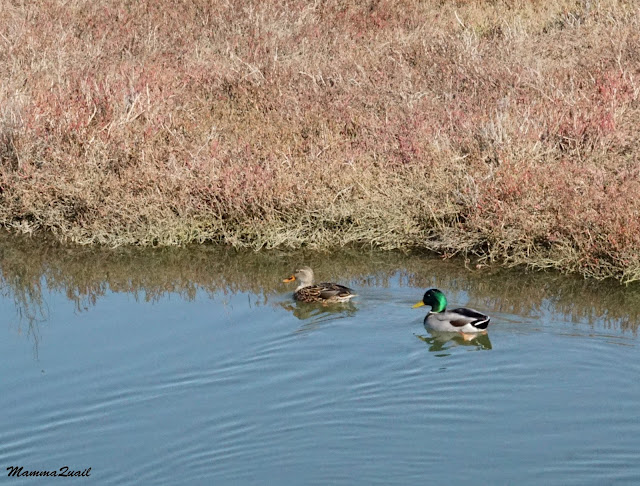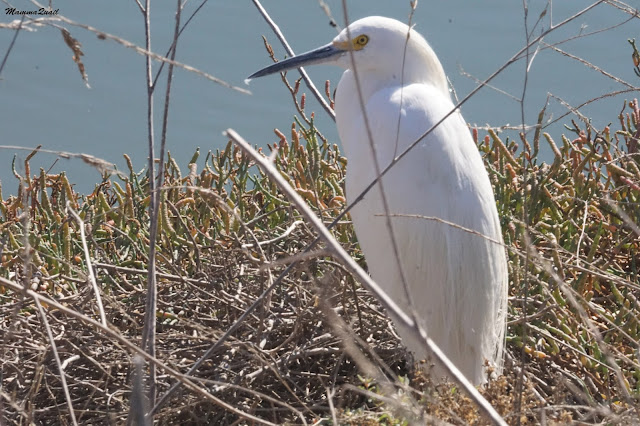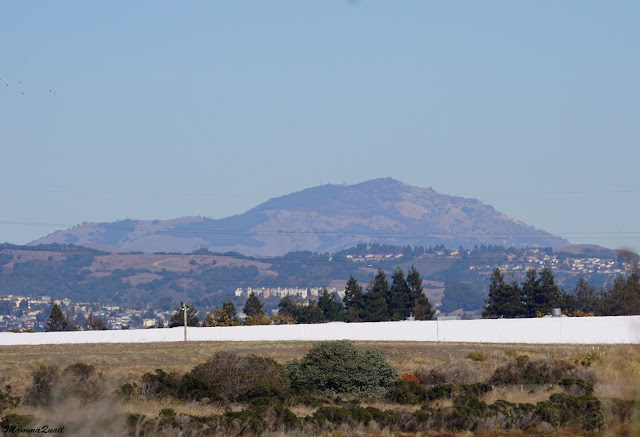Place: Hayward Shoreline Regional Park, Hayward, California
Address: 3010 W Winton Ave, Hayward, CA
Length: 3.9 miles
Level: easy
Hayward Shoreline is one of the best places in the Bay Area to see wildlife up close. Mostly feathered wildlife, but others as well. Along the 9 miles trail that stretches from the Hayward Shoreline Interpretive Center (HSIC) in the south by CA-92 to the San Leandro Marina in the north there are sloughs, ponds, and restored wetlands and salt marshes that are year-round home to numerous species of local birds and an essential wintering grounds to many more species of migratory birds.
It is also a great recreational trail for hiking and biking, flat and easy, with great bay view and refreshing breeze.
Usually I hike the shoreline from the south and finishing the hike with a visit at the center. The hike I'm posting here is in the middle section of the shoreline, starting and finishing at the Winton Ave. entrance.
The direct path from the parking lot to the bay is along the slough. A few green bushes, but mostly dry weeds separate the trail from the water. On one of these weeds: a black phoebe stands on watch.
 |
| Black Phoebe |
 |
| Canada Geese |
I didn't expect to see any bloom at this time of year, but there was some. The California coastal region never fails :-)
The tidal water flows between the salt marsh sections via a system of sloughs and canals, moving from one to the other through pipe holes like the one at the bottom of this photo:
A little whirlpool forms where the incoming tide water flows into the pipe hole. The children watched with intense fascination.
This fascination wasn't experienced only by the kids :-)
Tidal water regularly floods the salt marsh areas, supporting the specialized plant life and the numerous birds and other wildlife that depends on the tidal cycle.
 |
| Willet |
I continued south along the waterfront, keeping the low hill to the east on my left and a narrow stretch of salt marsh in between us.
My first hike there was right after some rainfall and the view was nice and clear. By my later hikes the air has already gotten to murky to see anything on the horizon.
The dominant salt marsh plant is the pickleweed. In the cool october time it was turning rusty-red: a perfect background for the ever-present egrets.
 |
| Great Egret |
 |
| Great Blue Heron |
 |
| Mallard, female and male |
 |
| Snowy Egret |
The source turned out to be a gopher snake: a gentle, non-venomous Bay Area resident that was mimicking the sound of a rattlesnake in an attempt to scare me away.
 |
| Gopher Snake |
Eventually, of course, I did walk away, leaving the snake alone.
A smaler slough to my south was full with high tide water on my firs hike. On my last one, however, the tide was low and the exposed mud was like open table for sandpipers and other shorebirds.
The second, part of my hike traverses another restored salt marsh area. The levee that confined a salt pond was removed and the tidal cycle returned. Salt marsh vegetation was reintroduced and with it, returned also the birds.
The one species I saw most in the salt marsh on my November hikes was the curlew: a large wader with an extra large beak.
The trail goes on a long bridge that crosses the breached levee area and leads once more to the bay waterfront. On a clear day, as was on my first hike there, the San Mateo Bridge can be seen bulging above the water.
On the third, least clear day hike, the peninsula was entirely invisible, completely hidden behind a curtain of murky air.
Clearer view right overhead: a couple of cormorants in commute.
There, along the bay waterfront I saw another salt marsh plant, and it too was blooming.
Curving back eastward, a large brown building comes into view a few miles south. This building, just off to CA-92 on the eastern side of the San Mateo Bridge, is the Hayward Shoreline Interpretive Center. I used to visit there often when we lived in Castro Valley and the chikas were little. I love that place and the wonderful educational work they do there with people of all ages. I have posted about it in this blog a while ago.
 |
| The Hayward Shoreline Interpretive Center |
More out toward the bay: a small group of ruddy ducks floating lazily on the calm water, hiding their bills under the wing.
Other, less sleepy ducks, were swimming in the slough. A large group of northern shoveler hurried away from me just when I lifted my camera. I managed to capture the slowest one.
 |
| Northern Shoveler, male |
After properly appreciating all the waterfowl I continued north along the eastern segment of the loop trail around the marsh. Large 'islands' of smooth cordgrass patched the salt marsh area east of the trail. This grass is not native to California and is highly invasive - quickly taking over the restored wetlands and changing the habitat to exclude many species that depend on the open pickleweed grown tidal zone fields. Active efforts are taking place to remove and control the invasive cordgrass.
Lifting my eyes to look further away, much further away: the dome of Mt. Diablo towering to the northeast. I haven't been there in some time. As I walked along the Hayward Shoreline trail I was already planning in my head my next visit to Mt. Diablo.
Cutting through the flooded wetlands was the dry, high-ground trail. Along the trail - many ground squirrels running between their squirrel holes. It felt like the trail sides are in constant motion.
Constant motion - and not only because of the squirrels. Little bush birds buzzed in the tall, dry weeds and the perennial shrubs. Many of them were sparrows.
The most common sparrow there is perhaps the white-crowned sparrow. Maybe common, but still very nice to see. And this particular individual landed right next to me and gathered bits of dry vegetation with complete disregard to my presence. This is how I got this wonderful view of its crown.
 |
| White-crowned Sparrow |
 |
| Savannah Sparrow |
 |
| Yellow-rumped Warbler |
As I continued strolling along the trail a northern harrier swooped by. Also known as march hawk, this raptor is a common sight soaring over the coastal wetlands.
 |
| Northern Harrier, male |
An American pipit crossed our path and Papa Quail, who joined us for the 4H Hiking Project hike gave it a lot of attention.
 |
| American Pipit |
 |
| Western Meadowlark |
Just before reaching the park's entrance there is a small hill east of the trail and what seems like a vehicle trail that goes up it. I walked up there a little bit before I realized it doesn't really lead anywhere in particular. It did take me, however, close enough to that white spot I saw earlier on the bushes underneath: that was another beautiful raptor: a white-tailed kite.
Coming back down and circling the hill on the official trail I had the strange feeling I was being watched ... |
| Canada Geese |
Just before exiting the park I heard a commotion near the slough I started my hike at. Looking there I saw two huge jackrabbit running, one chasing the other. The one that was running away took a dive into the bushes and the other one sat outside and flicked its ears.
 |
| Black-tailed Jackrabbit (Lepus californicus). It's actually a Hare. |
 |
| Anna's Hummingbird, male |
 |
| Common Raven |
 |
| Ruby-crowned Kinglet |


























great wildlife sighting! the snake was of course my favourite :-)
ReplyDeleteI thought it would :-) I loved the snake encounter too. I'm not sure it loved it as much.
Delete